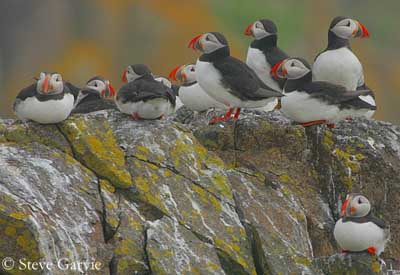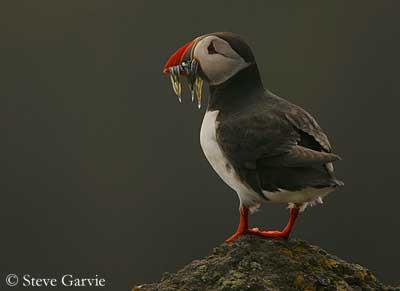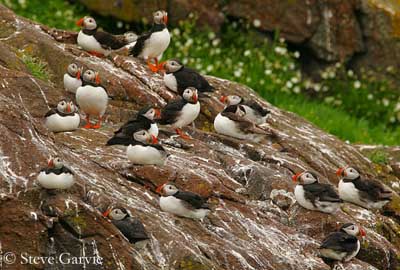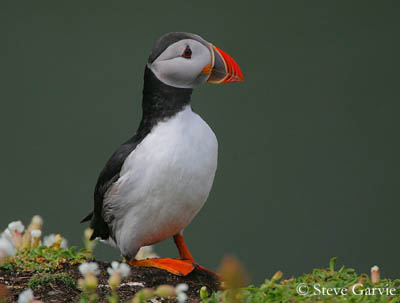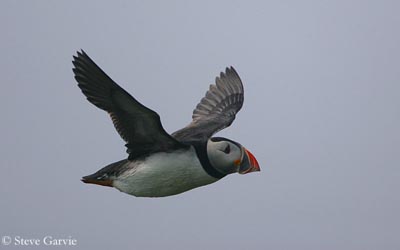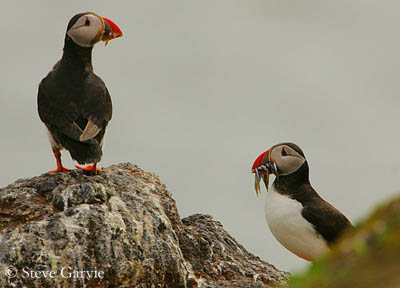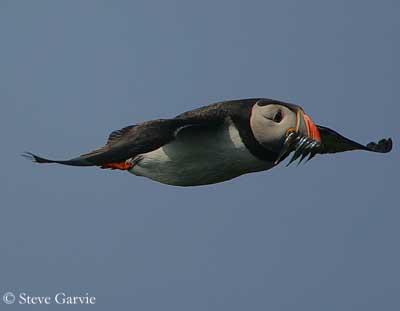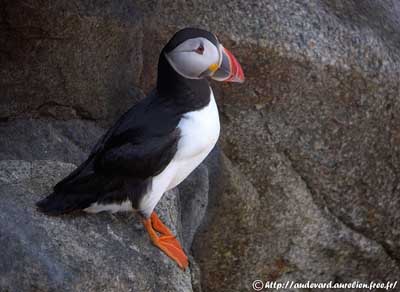
Atlantic Puffin
Fratercula arctica
Charadriiforme Order – Alcidae Family
BIOMETRICS :
Length : 26-36 cm
Wingspan : 47-63 cm
Weight : 460 g
LONGEVITY: between 13 and 20 years in average, maybe more.
DESCRIPTION:
Atlantic Puffin is a comical looking seabird. It has chunky body with short wings. It is sometimes called the “Sea-Parrot”.

In breeding plumage, adult has black upperparts and white belly and vent. Underwing is dusky. Forehead, crown and nape are black.
A black collar extends from nape and back to the foreneck, above the breast. Face is grey and white. Eyes are brown with red eye ring. A small vertical black patch above the eyes and other horizontal below, continue in a fine black line behind the eye and extending to the nape.
Bill is triangular-shaped and bulky, as laterally compressed. On the upper mandible, it is formed with alternating horny ridges, red-orange, blue-grey and yellow. This mandible is very slightly down-curved.
Legs and webbed feet are bright orange.
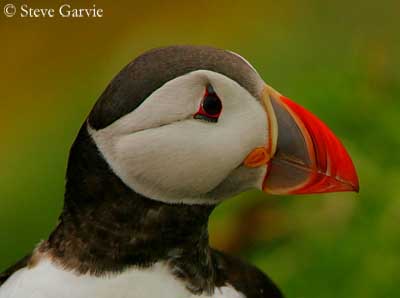
Adult in winter plumage becomes duller. The bill sheds its outer horny plates, becoming smaller and thinner, grey and yellowish. Face becomes blackish-grey with much darker loral area. Belly turns greyish and the plumage in tinged greyish on the black upperparts. Legs and feet are duller, becoming yellowish.
Male and female are similar.
Juvenile resembles adults but it has smaller size. Bill is duller, darker and smaller, and show fewer than two horny plates on the upper mandible, giving it pointed-long shape. Legs and feet are duller and rather pinkish.
Young breeds at 5-6 years of age.
VOICE: SOUNDS BY XENO-CANTO
Atlantic Puffin is rather silent away from colonies. On breeding grounds, we can hear low growling “kaa-arr-arr” often repeated.
HABITAT:
Atlantic Puffin is an exclusive marine bird. It breeds on coastal grassy slopes, but also on sea cliffs, adjacent boulders and scree-covered slopes.
During winter, it ranges in offshore and pelagic habitats, mainly on deep, icy water. It is rarely seen on land, except for breeding.
RANGE:
Atlantic Puffin lives in Northern Atlantic and Arctic, including Greenland, N Canada, Gulf of St Lawrence, Nova Scotia, Iceland, N Scandinavia, N Russia, Ireland and NW French coasts.
BEHAVIOUR:
Atlantic Puffin stores the preys in its large bill which may contain up to 30 fishes! In order to capture others, it wedges the first fishes between the tongue and the upper mandible, and continues fishing. They are well adapted to underwater fishing, often up to 15 metres depth. They feed in small flocks of 2 to 3 birds.
Atlantic Puffin dives while flying of from the surface, and “swims” underwater with the wings used as paddles. Webbed feet are only used to change direction while swimming.
Outside the period of feeding young, it swallows the preys right now and under water. When adults carry prey to their young, they may be chased by gulls and skuas. They can escape by crashing into the water.
Atlantic Puffin is a highly social species. These birds nest in colonies and live in groups. They roost at sea, with the bill under the wing.
The large bill is used to excavate the burrow where is located the nest. But during the courtship displays, this decorated bill with bright colours attracts the females. And during courtship, mates perform the “billing”. They touch their bills and male is often so excited that it pushes the female downhill on the grassy slope.
During this period, mates may also fight on the water, attracting other pairs. They pair on the water. Mates stay together through the breeding season, often sit outside the burrow. They are monogamous.
On the ground, Atlantic Puffin walks, sometimes it may run. It stands upright on its webbed feet. They live in colonies, and they are very inquisitive and tame. They often appear comical, hopping around the burrow with angling head.
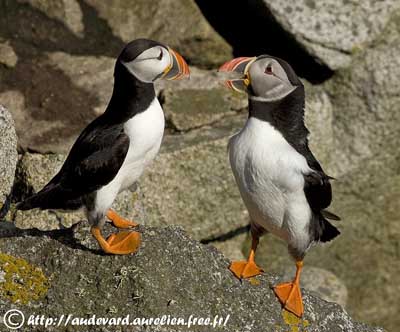
FLIGHT:
Atlantic Puffin has short wings which propel the bird forwards underwater. But in spite of the stocky short-winged body, this bird performs fast flight with very rapid wing beats. It is able to reach speeds of about 80 km per hour.
When in flight, large head and bill give a rounded profile to the bird. It may run across the surface of the sea to take off.
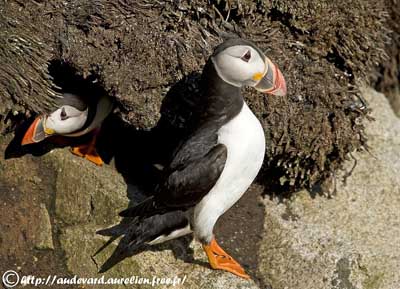
Female lays a single white egg with brownish markings. Incubation lasts about 36 to 45 days, by both parents. They put the egg under the wing and prop themselves against the nest. They take long turns of about 30 hours.
At hatching, the chick is covered with brownish-black down. It is fed by both adults. They bring food at nest, holding the small fishes in the bill.
Then, about 40 days later, the adults leave the nest and the young and return to the sea until next March.
The young does not feed during one week, and at the end, it jumps from the cliff top down to the sea, mainly at dusk. At this moment, it fishes and dives for food as adults, and it will fly 10 days later.
Atlantic Puffin only produces one brood per year, with a single egg.
DIET:
Atlantic Puffin feeds mainly on fish all year round. In late summer, it also consumes small crustaceans and squid. It feeds by diving and pursuing preys under water.
Young are exclusively fed with fish first, and later, parents add some invertebrates.
PROTECTION / THREATS / STATUS:
Atlantic Puffin populations declined, probably caused by climatic changes and sea temperature. Pesticides and oil pollution are other important threats for this species.
Atlantic Puffin is shot for food and feathers in some parts of its range. They are often attacked and killed by gulls, large seabirds, rats, cats, dogs and foxes when near or in burrows.
Decline now appears to have stopped, and some northern colonies may be increasing.
Fr: Macareux moine
All : Papageitaucher
Esp : Frailecillo Atlántico
Ital : Pulcinella di mare
Nd : Papegaaiduiker
Russe : Тупик
Sd : Lunnefågel
Photographs by Steve Garvie
His website:
RAINBIRDER Photo galleries
Photographs by Aurélien Audevard
His website :
OUESSANT DIGISCOPING
Text by Nicole Bouglouan
Sources :
HANDBOOK OF THE BIRDS OF THE WORLD Volume 3 by Josep del Hoyo-Andrew Elliott-Jordi Sargatal - Lynx Edicions - ISBN : 8487334202
THE HANDBOOK OF BIRD IDENTIFICATION FOR EUROPE AND THE WESTERN PALEARCTIC by Mark Beaman, Steve Madge - C.Helm - ISBN: 0713639601
L’ENCYCLOPEDIE MONDIALE DES OISEAUX - Dr Christopher M. Perrins - BORDAS - ISBN: 2040185607
All About Birds (Cornell Lab of Ornithology)
Wikipedia (Wikipedia, The Free Encyclopedia)
Birds of Nova Scotia (Robie Tufts)
